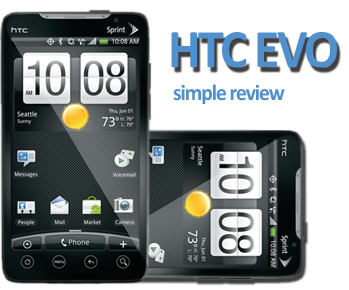
The HTC EVO 4G turned one year old on June 4th, and with the rate that smart phone technology has been progressing, many may be wondering if it has already been made obsolete. When it was released last year, the EVO was one of the top phones on the market. Its popularity owes itself to heavy marketing by Sprint, the exclusive carrier for the device, as well as the fact that it was one of the only 4G smart phones on the market. Now with many other 4G phones on the market, and Apple set to unveil yet another iPhone with rumored cloud computing functionality, how does the EVO 4G stack up a year later?
One of the benefits of being one of the most technologically advanced phones released last year is that the hardware in the EVO still holds up pretty strongly today. With an 8 megapixel camera on the back, and a 1.3 megapixel camera on the front, few phones can beat its photo functionality. As for its display, the 4.3 inch screen is still one of the largest on the market. Internally, the 1 GHZ Snapdragon processor is fast enough to power even the most resource-intensive applications. In the connectivity category, the EVO can be connected to a computer via a micro-USB connection or wirelessly using its Bluetooth or WiFi connectivity. While these are fairly standard in nearly any smart phone, the 4G connectivity is what has set the EVO apart from competitors, offering one of the fastest wireless connections of any phone. The additional speed is necessary for video calls, cloud streaming, and video downloads. While 4G is becoming more common, the EVO 4G is still one of the devices that does 4G the best.
While the hardware is definitely still able to compete with newer smart phones, most mobile users are also concerned with applications. While it’s not quite as well-supported as Apple’s iPhone, the EVO does have access to a wide variety of applications thanks to the Android Market. Over the past year, the Android-based EVO has gained access to Netflix and Angry Birds, two of the iPhone’s most popular applications. In addition to these, a wide variety of games, social networking apps, and other programs have come to the device. The EVO has also received additional functionality thanks to frequent firmware updates, such as the recent “Gingerbread” release which saw the EVO gain improved battery life and improved text input. The next planned release, “Honeycomb,” is supposed to add cloud music streaming support for the device, as well as other unannounced features.
As smart phones go, the HTC EVO 4G is still one of the best options available for anyone looking to buy a phone. While the initial shine may have worn off a bit, the up-to-date hardware and continued software updates make the phone hard-to-beat. And if you still crave a “new” phone, the upcoming HTC EVO 3D has all the functionality of the original with the addition of a 3D display.
Guest post by Michael.
